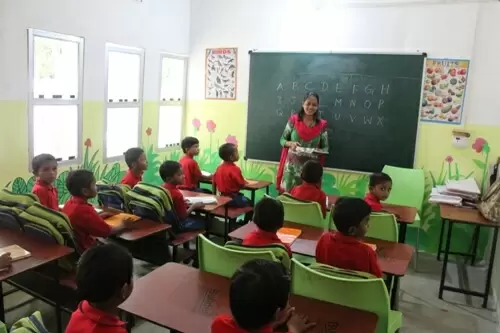A unique educational experiment in Madhya Pradesh's tiger country
22-December-2018
Vol 9 | Issue 52
Six-year-old Vinannya Uikey wakes up excited every morning to go to school where she can not only learn new things about the world but also play with fascinating toys. What's different about Vinannya compared to the millions of other school children in India is that she belongs to the adivasi (aboriginal) Baiga tribe for whom playschools are an unknown concept.
And what's different about the school is that it is situated bang in the middle of a famous tiger reserve in central India and its students comprise children of both indigenous tribes and forest officers.
 |
|
Equipped with modern classrooms, the Kanha Bhoorsingh Playschool introduces tribal children for the first time to picture books, toys, and even computers (Photo: IANS)
|
Situated at the Mukki zone, the school -- named after the famous mascot of the Kanha Tiger Reserve "Bhoorsingh the Barasingha (swamp deer)" -- introduces the tribal children for the first time to picture books, toys, and even computers and projectors.
Attracting children from 10 neighbouring villages, mostly from the Baiga tribe, Kanha Bhoorsingh Playschool brings them together with children of forest officials. They study in the same "smart classrooms", eat the same food and cavort together in the same playground.
Ashu Bisen, one of the teachers in the school, said that most tribal children are extremely shy and sensitive, and mostly scared in the beginning.
"We have to interact with them carefully and start from scratch. Most of the children don't have toys at home; they see computers, projectors, and in some cases the picture books, for the very first time. We have to be very patient with them. But given time, they show commendable results," she said.
S.K. Khare, the assistant director of the Kanha National Park, said the idea was to eliminate the inferiority complex that tribal children had when they interacted with the outside world
Madhya Pradesh has one of the largest tribal populations in the country, mostly living around the forests. Though marginalised, rising awareness of education among the tribal communities often encourages them to move towards urban habitats. But tribal children often lag behind as they can't relate to their city counterparts.
"What we do here is an attempt to bridge the gap between mainstream and tribal children, because some day these children will move out and they often feel left out. Our aim is to build a foundation so that when they go for better and higher schooling, then they do better," said Khare.
Incidentally, the school, operational since 2017, runs in the bungalow which was allotted to Khare when he was posted here. However, he decided to shift to a smaller accommodation and put the bungalow to a better use. It was then refurbished to have three classrooms, a computer lab, two projector rooms, a mini library, a staff room and a kitchen.
Run by the Last Wilderness Foundation, along with some other 20 odd donors, forest officials also send their children to the school which offers education till upper kindergarten. School teachers are all wives of forest officers.
Khare said that it is not just the tribal children who benefit from the school, but children of officers also get a chance to develop sensitivity, broader acceptability and a better understanding of diversity, especially when they interact with their classmates who come from a different background and outlook, some even wearing tribal tattoos.
"It is a good thing that both forest officials and tribals don't hesitate to send their wards to the same school. This shows the trust that we have been able to develop among us," he added.
According to Richa Namdev, a teacher, better education does not have impact on lives of only the children but also their families.
"Most of the children come from extremely poor backgrounds. Grooming these children has great impact as they often tend to take their learning from here and replicate it at their houses. Some have started urging their parents to have better hygienic values, while some urge their parents to learn to read," Namdev said.
As the recess bell rings, students dressed in their red school uniforms collect the toys of their choice and rush to play. After another ring they assemble for their meals in the lawn. Sitting on the carpet, the caretakers serve them a freshly-cooked, nutritious meal. After the meal, a batch leaves to the projector room for the movie day, while another group leaves for computer room.
"We provide them books, school dresses, bags and meals here. Although we have also kept a small fee of Rs 150 per month, in case of very poor families, we generally drop the fee," said Nisha Vaishya, another teacher.
According to Khare, the idea of charging a fee is to keep the value of education intact. "It also honors the self-respect of the tribes who don't want anyone's charity."
"The school is showing good results and more and more families are sending their children, especially after seeing how our students are being groomed. Everyone aspires to get quality education, especially those who are marginalised," Khare said adding that considering the potential they saw in the children, it shows they have a great future.
"What we see as national parks today had been protected for years by tribes like Baiga and Gond. They are the real protectors and it's their home. It's time for the mainstream to return the favour. This school is a humble attempt to do the same," he added. - IANS














